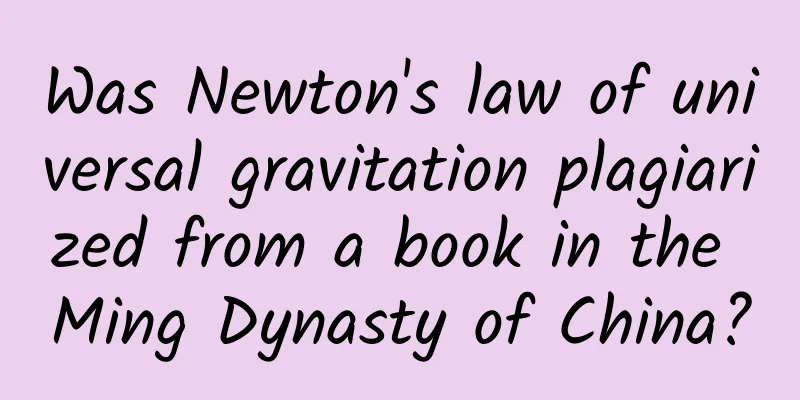Was Newton's law of universal gravitation plagiarized from a book in the Ming Dynasty of China?

|
Recently, there have been a lot of hilarious "history of science" and "short video science" on some online platforms. For example, there is a statement that has attracted widespread attention: The law of universal gravitation was not discovered by Newton. In fact, Newton stole the law of universal gravitation discovered by a Chinese named Wang Zheng from a book called "Illustrated Explanations of Strange Instruments" from the Ming Dynasty of China. Image source: News screenshot Just looking at the time, it seems to make sense. Newton published his theory of universal gravitation in 1687 through his book Mathematical Principles of Natural Philosophy, which is the 26th year of the reign of Emperor Kangxi in the Qing Dynasty. Wang Zheng's Illustrated Explanation of Strange Instruments was published in the 7th year of the reign of Emperor Tianqi in the Ming Dynasty (1627). If the scientific principle that Newton would publish 60 years later already appeared in a book published in the Ming Dynasty, it seems that it is a foregone conclusion that the latter plagiarized the former! It sounds impressive, right? Let’s take a closer look at what this “Illustrated Explanation of Strange Instruments” is about and what about the law of universal gravitation discovered by Newton. The title of the book points out that Ming Dynasty scholars learned European scientific knowledge First of all, we should make it clear that “奇器图说” is not the full name of this book. It also has the words “远西” in the front, which refers to the knowledge learned from missionaries. China’s understanding of the land and culture in the West has different names such as “西域”, “西天” and “天方” to refer to different distances. When missionaries such as Matteo Ricci came to China, they invented terms such as “远西”, “泰西” and “大西洋”. These terms actually reflect the process of our gradual understanding of the world over a long period of time [1]. The Illustrated Explanation of Strange Instruments from the Far West was dictated by German missionary Deng Yuhan, written and illustrated by Wang Zheng, and published in Yangzhou in 1627. It is the first book in my country to introduce modern European mechanical engineering and mechanics. The so-called "introduction to the description of universal gravitation" in the Illustrated Explanation of Strange Instruments from the Far West [2] is actually a misreading by the netizens who interpreted this passage. Volume 1, page 17: "The heaviest thing is the earth. The earth is under the sky and must be in the center." Volume 1, page 19: "Each object wants to go straight down to the center of the earth. The nature of gravity is to go down, and the center of the earth is its origin. So, just as a magnet attracts iron, and iron tends to go to the stone. No matter whether the stone is above or below, left or right, the iron will go there. This is its nature." We have all been educated in Newtonian physics, so it is easy to think that this passage is from a high school physics textbook. But in fact, it is not about "universal gravity". As a Zhihu netizen pointed out, there is no mention of "force" here. The previous paragraph said that "the center of the earth is the center" is Aristotle's geocentric system, and explained why the earth must be round, because the center of the earth is also the center of the universe. In other words, the so-called "down" is the direction of the center of the earth, and the top is the direction of the head. Because the earth is a sphere, people all over the world actually stand towards the center of the earth. Image source: pexels The latter part discusses Aristotle’s “Four Elements Theory”, which is Aristotle’s physics. It emphasizes “nature”. The nature of elements is divided into two categories: earth and water move downward by nature, while air and fire move downward by nature (and ether moves in a circle in the sky). Therefore, heavy objects such as earth and water form the round earth. There is no “force”, but the emphasis is on “nature”. This is the characteristic of Aristotle’s physics [3]. We now think this is easy to understand and simple, because we have learned Newtonian physics. Newton used the law of universal gravitation to tell us which of Aristotle's views were right and which were wrong, and where they were wrong. Before Newton, many people found Aristotle's statement incomprehensible - people on the opposite side of the earth, wouldn't that be "upside down"? So there can't be anyone on the opposite side, right? This question is the famous "Antipodian Problem" in the history of European academics. It was not until the Age of Exploration, when European navigators crossed the equator and the Atlantic Ocean and discovered the New World, that people realized that there were indeed people on the other side of the Earth. Scientists once used magnetism to explain the solar system As for the latter part, the analogy with magnetism was the idea of William Gilbert (1544-1603), the royal physician of Queen Elizabeth I of England, after studying magnets. German astronomer Johannes Kepler (1571-1630) agreed with Gilbert, and they tried to use this to explain from a physical point of view why the earth is round and why the earth revolves around the sun. They were contemporaries of Xu Guangqi and Wang Zheng. Strictly speaking, this analogy is actually wrong. After all, the properties of gravity and magnetism (which were later confirmed) are very different. Gravity only attracts each other, while magnetism attracts opposites and repels likes. Their sources are also different. This misunderstanding that once occurred also shows that science is a process of gradual development and trial and error. No theory is achieved overnight and remains unchanged. The reason for the misunderstanding is that they were discussing the same phenomenon (the earth is round) and the same topic (why the earth is round). Aristotle believed that the earth is round. Although this conclusion has a certain scientific basis, he did not really describe how this conclusion was correctly derived. Some of his premises are now considered to be wrong, so it can only be described as a "qualitative" description. Newton's law of universal gravitation ushered in a new era of physics To quantitatively solve this problem, two great men, Kepler, Galileo and Newton, were needed. Kepler pointed out that the planets orbit the sun in elliptical orbits, thus completely getting rid of the ancient Greek concept of "perfect circular orbits". Galileo pioneered the introduction of mathematical quantitative analysis into physics, and began to study the relationship between motion and force, thus being able to study the motion process. Image source: pixabay Newton developed the three major laws of kinematics, the law of universal gravitation, and calculus, a must-learn mathematics for college students today. These discoveries of mechanical principles based on more complex mathematical foundations led to the name "Newtonian mechanics" [4]. The first problem Newton solved came from British astronomer Halley. In 1684, Halley posed a question to Newton that had not been solved at the time: if a planet is subject to gravity from the sun, and this gravity is inversely proportional to the square of the distance, then what will its orbit be like? Newton answered without hesitation that he had proved that the orbit is elliptical. This conversation allowed Halley to push Newton to publish his theories, which resulted in the three-volume book "Mathematical Principles of Natural Philosophy" published in 1687. Halley was also able to calculate the orbit of his favorite comet and predict the return of one, the famous Halley's Comet, which will return in 2061. In other words, the theory of universal gravitation cannot be fully described in just a few dozen or a few hundred words . It must be rooted in the properties and effects of objects summarized by Newton (beyond Aristotle, Gilbert and Kepler), the three laws of motion (beyond Galileo), and calculus (beyond ancient Greek mathematics), so as to solve the physical process of elliptical orbits, where the magnitude and direction of forces and velocities are constantly changing. The theory of universal gravitation solved the major issues since Aristotle and Copernicus - why the earth is round and why the solar system is like this. Newtonian mechanics reshaped our basic understanding of the universe and the daily world. Today, even when we talk about things outside of physics, we often use the concept of "force", all of which demonstrates the great influence of Newtonian mechanics. Image source: pixabay Wang Zheng could not learn Newtonian mechanics because he died in 1644, the year Li Zicheng attacked Beijing. At that time, Newton was only two years old. But I think if he could travel to the future, he would study harder. After all, he was "Xu (Guangqi) in the South and Wang in the North", one of the two most powerful scholars in the Ming Dynasty who spread Western academic knowledge. As descendants, we do not need to force Newton's beauty on Wang Zheng, but learn from his broad mind and humble spirit of learning, which is the real self-confidence . Only on this basis can we continue to innovate and move forward. If we indulge in the false "past glory" and forget the gap in reality, we will also lose the future. References [1] Wu Mengxue, Preface to China in the Eyes of Europeans during the Ming and Qing Dynasties, Zhonghua Book Company, 2000 [2] The Illustrated Record of Strange Instruments from the Far West, with the Latest Illustrated Descriptions of Various Instruments, Zhonghua Book Company, 2016 [3] Aristotle, Physics, The Commercial Press, Chinese Translation of World Academic Classics Series, first edition in 1982. [4] Wu Yiyi, From Copernicus to Newton: The Establishment of Heliocentrism, Shanghai People’s Publishing House, first edition in 2013. Planning and production Author: Sun Zhengfan, PhD in Astronomy, popular science author Review丨Sun Yifei Director of the Medical Education History Research Office of Hebei Medical University Planning丨Xu Lai Editors: Lin Lin, Bai Li |
<<: AR Technology Part 4: Entering the Tokamak
>>: Can eating bananas relieve constipation? Not true! Such bananas will aggravate the symptoms
Recommend
2021 hot marketing calendar for the whole year! Hot spot analysis included
Whether you are doing new media operations, marke...
Nokia brand, worth $55.2 billion in 2008, now discontinued
[[121650]] According to media reports, Microsoft ...
Do your fingers turn white and purple in cold weather? Don't ignore it, it may be "Raynaud's phenomenon"
Many people have experienced their fingers being ...
What is the difference between cloud protection and high-defense server?
What is the difference between cloud protection a...
The man was found to be driving under the influence even though he had not drunk any alcohol. It turned out that he had this bacteria in his body! The treatment method is cruel...
One late night in April 2020, in the small town o...
Operational promotion: 4 steps to detonate your growth!
What I want to share with you today is that user ...
The bitter fruit of the new policy: We are back to the era when taxis are expensive and difficult to get
Since the new online car-hailing policy was offic...
As the global market continues to decline, autonomous driving technology provider Mobileye comes to China to seek business support
Recently, Mobileye, a world-renowned provider of ...
4 major strategies revealed, there is no more comprehensive information on live broadcast product selection!
2020 can be called the first year of live streami...
Does your toilet smell like rotten eggs? Be careful!
If you smell a pungent smell of rotten eggs in th...
Google researchers discover Apple introduced improved iMessage security for iOS 14
Apple released iOS 14 last fall, introducing a ne...
What are the functions of the Lanzhou check-in mini program? How to create a check-in app on WeChat?
A few days ago, a boss called me and wanted to mak...
A new type of colored fiber cotton has been successfully created. Will there be colorful cotton in the future?
Science Fiction Network, January 6 (Xu Mingyang) ...
Five-minute technical talk | Application of analytic hierarchy process (AHP) in user experience design evaluation
Part 01 What is AHP? AHP, or analytic hierarchy p...









